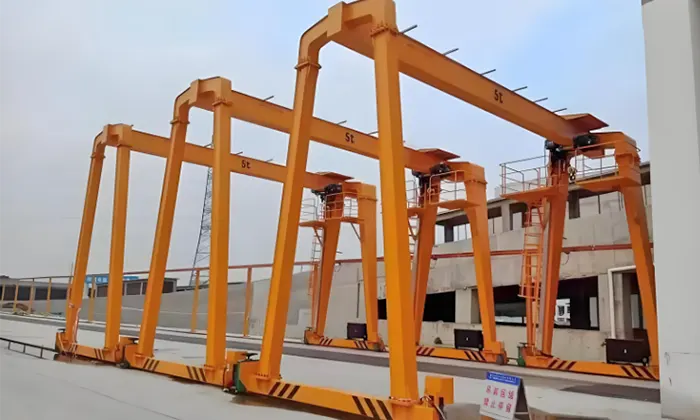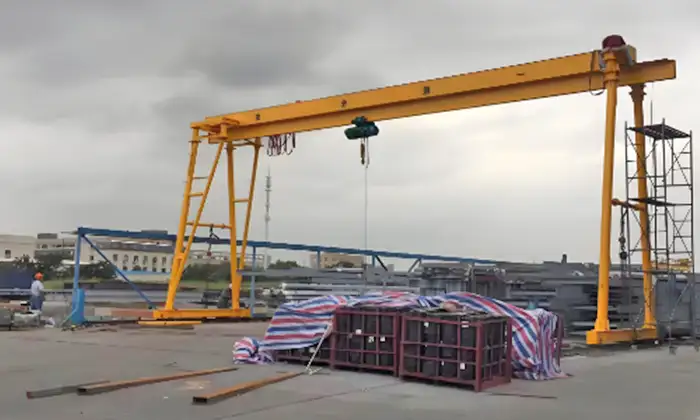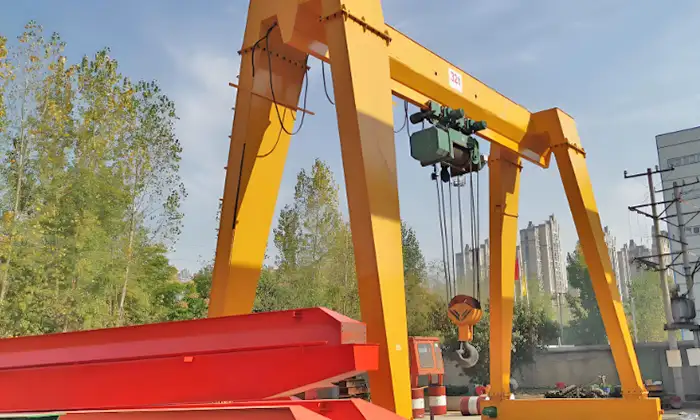Cost Analysis of Single Beam Gantry Cranes (1 Ton to 20 Ton)
Cost analysis of single beam gantry cranes (1-20 tons) includes purchase, operational, and lifecycle costs for informed decision-making.
Overview of Single Beam Gantry Cranes
Single beam gantry cranes are versatile lifting solutions widely used in various industries for their efficiency and flexibility. They feature a single beam supported by two legs that run on tracks or wheels, allowing them to move across a workspace. These cranes are commonly employed in manufacturing, construction, and warehousing applications to handle loads of varying capacities. Their design typically offers a more cost-effective solution compared to double beam gantry cranes, especially for lighter loads and shorter spans.
Importance of Cost Analysis in Crane Selection and Budgeting
Conducting a thorough cost analysis is crucial when selecting single beam gantry cranes. Understanding the total cost, including initial purchase, operational, and lifecycle expenses, helps businesses make informed decisions that align with their budget and operational needs. By evaluating various cost factors, companies can optimize their investment, enhance productivity, and ensure long-term financial efficiency.
Initial Purchase Costs
Crane Specifications and Configurations
- Standard vs. Customized Designs: Single beam gantry cranes come in both standard and customized designs. Standard models are generally more affordable, while customized designs can be tailored to specific operational requirements, such as extended spans or unique load handling features. Customized options, however, tend to come at a higher price due to additional engineering and manufacturing costs.
- Load Capacity and Span Requirements: The cost of single beam gantry cranes varies significantly based on their load capacity and span. Higher load capacities and longer spans generally result in higher costs. For instance, a 1-ton single beam gantry crane will be less expensive than a 20-ton crane due to differences in structural requirements and materials.
Material and Components
- Steel Construction and Its Cost Implications: Single beam gantry cranes are predominantly made from steel, known for its strength and durability. Steel construction is generally cost-effective but can vary based on the grade and treatment of the steel. High-strength or corrosion-resistant steel may increase the overall cost but offers better performance and longevity.
- Standard vs. Premium Components: Cranes equipped with standard components are typically less expensive, while premium components, such as advanced control systems or high-efficiency motors, can drive up the price. The choice between standard and premium components depends on the specific needs of the application and budget constraints.
Manufacturing and Delivery
- Production Costs: The manufacturing costs of single beam gantry cranes involve labor, materials, and overheads. Customizations or additional features can increase these costs.
- Shipping and Installation Fees: Shipping and installation are additional costs to consider. These fees can vary based on the crane’s size, weight, and delivery location. Ensuring proper installation is crucial for safety and optimal performance.

Cost by Capacity
1 Ton Capacity
- Typical Costs: Single beam gantry cranes with a 1-ton capacity typically range from $2,200 to $10,000. The cost variation depends on factors like span, height, and additional features.
- Factors Influencing Price: Key factors influencing the price include the crane's span, lifting height, and whether it includes additional features such as electric hoists or specialized controls.
5 Ton Capacity
- Typical Costs: For a 5-ton single beam gantry crane, costs usually range from $3,000 to $15,000. The price increase reflects the higher load capacity and potentially larger dimensions.
- Factors Influencing Price: Prices are affected by the crane's length of span, lifting height, and any added features or customization.
10 Ton Capacity
- Typical Costs: A 10-ton single beam gantry crane is generally priced between $4,000 and $20,000. The significant load capacity contributes to the higher cost.
- Factors Influencing Price: The main cost drivers include the crane’s span, additional load-handling features, and customization options.
20 Ton Capacity
- Typical Costs: Single beam gantry cranes with a 20-ton capacity can cost between $6,000 and $30,000. The higher cost is due to the increased structural requirements and load handling capabilities.
- Factors Influencing Price: Key factors include the crane’s span, height, any advanced features, and the cost of materials and components used in construction.
Operational Costs
Energy Consumption
- Power Requirements: Single beam gantry cranes require different power levels based on their size and load capacity. Generally, cranes with higher lifting capacities and advanced features will consume more energy. For instance, a 20-ton crane will typically need more power than a 1-ton crane due to its larger motor and lifting system demands.
- Operational Efficiency and Energy-Saving Options: Investing in energy-efficient components such as high-efficiency motors and variable frequency drives (VFDs) can significantly lower energy consumption. Regular maintenance, including checking for system leaks and ensuring proper alignment, also helps maintain energy efficiency and reduce operational costs. Implementing energy-saving practices and technologies can result in long-term savings on utility bills.
Maintenance and Repairs
- Routine Maintenance Schedules: To ensure the longevity and reliable performance of single beam gantry cranes, regular maintenance is essential. This includes scheduled inspections, lubrication of moving parts, and adjustments to mechanical systems. Establishing a routine maintenance schedule helps prevent unexpected breakdowns and extends the crane's operational life.
- Common Repairs and Their Costs: Over time, single beam gantry cranes may require repairs due to wear and tear or mechanical issues. Common repairs include replacing worn-out components like wheels, hoists, and gears, or fixing electrical and hydraulic systems. The cost of these repairs varies depending on the extent of damage and the availability of replacement parts. Planning for these expenses in the budget can help manage maintenance costs effectively.
Training and Labor
- Operator Training Costs: Proper training for crane operators is crucial to ensure safe and efficient operation. Training programs typically include safety courses, certification exams, and hands-on training. The costs can vary based on the training provider, the length of the course, and the certification level required. Investing in quality training reduces the risk of accidents and operational inefficiencies.
- Labor Costs Associated with Operation: Operating single beam gantry cranes involves labor costs that include wages for crane operators and any additional personnel needed for setup, maintenance, and supervision. Labor costs can be influenced by factors such as the complexity of the crane operation, shift requirements, and the skill level of the workers. Efficient management of labor resources helps control these costs and enhances overall operational efficiency.

Lifecycle Costs
Durability and Longevity
- Expected Lifespan of Single Beam Gantry Cranes: The lifespan of a single beam gantry crane is influenced by factors such as frequency of use, maintenance practices, and operating conditions. With proper maintenance, these cranes can have a long operational life, often exceeding 10-15 years. Regular inspections, timely repairs, and adherence to maintenance schedules can significantly extend the crane’s effective lifespan, reducing the need for early replacement.
- Impact of Environmental Conditions: Environmental factors play a crucial role in the durability and longevity of single beam gantry cranes. Exposure to high humidity, extreme temperatures, and corrosive substances can lead to accelerated wear and tear. For instance, cranes used in coastal or industrial environments may require additional protective measures, such as corrosion-resistant coatings, to mitigate the impact of these harsh conditions.
Replacement Parts and Upgrades
- Costs for Replacement Components: Over the operational life of a single beam gantry crane, various components may need replacement due to wear and tear. Commonly replaced parts include wheels, hoists, and control systems. The costs for these replacement parts can vary depending on the type and availability of the components. Stocking essential spare parts and working with reliable suppliers can help manage these costs effectively.
- Potential for Future Upgrades and Their Costs: Upgrading a single beam gantry crane with modern features or technologies, such as advanced control systems or improved lifting mechanisms, can enhance its performance and efficiency. However, these upgrades come with their own costs, which need to be evaluated against the potential benefits. Consideration should be given to how the upgrades will improve operational capabilities and whether the investment aligns with long-term strategic goals.
Comparative Analysis
Single Beam vs. Double Beam Gantry Cranes
- Cost Differences and Performance Implications: Single beam gantry cranes generally have lower initial purchase costs compared to double beam gantry cranes. They are ideal for lighter loads and simpler applications. In contrast, double beam gantry cranes offer higher load capacities and greater stability, making them suitable for heavier and more demanding applications. The choice between single and double beam cranes should consider both the upfront costs and the performance requirements of the specific application.
- Cost-Effectiveness of Different Brands and Models: When evaluating the cost-effectiveness of single beam gantry cranes, it is essential to benchmark different brands and models against industry standards. Factors such as build quality, warranty, and support services play a significant role in determining the overall value. Conducting a cost vs. performance analysis helps in identifying the most suitable option for your needs, ensuring a balance between cost and functionality.
Comparative Analysis
Single Beam vs. Double Beam Gantry Cranes
Cost Differences and Performance Implications: Single beam gantry cranes are typically more cost-effective compared to double beam gantry cranes. This is due to their simpler design and construction, which reduces manufacturing and material costs. These cranes are suitable for lighter loads and shorter spans, making them a practical choice for applications with less demanding requirements.
In contrast, double beam gantry cranes, while more expensive, offer enhanced stability and higher load capacities. Their design, which incorporates two beams, allows for handling heavier loads and provides better balance and structural integrity. This makes them ideal for more demanding applications, such as large-scale manufacturing and heavy-duty lifting operations. The increased cost of double beam cranes is justified by their superior performance and ability to handle more complex tasks safely.
Cost-Effectiveness of Different Brands and Models: To determine the most cost-effective single beam gantry crane, it's essential to benchmark various brands and models against industry standards. Evaluating different options involves looking at several factors:
- Performance: Assess how each crane performs in terms of load capacity, lifting speed, and operational efficiency. Higher performance typically comes with a higher price tag, so it’s important to find a balance between performance needs and budget constraints.
- Reliability: Consider the reliability of the crane, including its durability and the frequency of maintenance required. Reliable brands with proven track records may offer better long-term value despite a higher initial cost.
- Customer Support: Evaluate the level of customer support provided by each manufacturer. Good support services can reduce downtime and maintenance costs, contributing to overall cost-effectiveness.
Cost vs. Performance Analysis: Conducting a cost vs. performance analysis involves comparing the total costs of ownership against the operational performance of the crane. This analysis helps ensure that the selected crane meets the specific operational needs efficiently while adhering to budget constraints.
- Initial Costs: Compare the initial purchase price of different cranes, considering whether additional features or customization are worth the extra expense.
- Operational Efficiency: Analyze how each crane's performance impacts operational efficiency. For example, a more expensive crane with advanced features may improve productivity and reduce downtime, which could offset the higher initial cost.
- Long-Term Costs: Consider long-term costs such as maintenance, energy consumption, and potential repairs. A higher initial investment in a more durable and efficient crane can result in lower overall costs over its lifespan.
By thoroughly comparing these aspects, businesses can make informed decisions that align with their operational requirements and financial constraints, ensuring they choose the most suitable and cost-effective single beam or double beam gantry crane for their needs.
32 ton gantry crane for sale, contact us to customized single beam gantry crane for your needs
Financial Considerations
Financing Options
Lease vs. Purchase: Deciding whether to lease or purchase a single beam gantry crane depends on your company's financial strategy and cash flow requirements.
- Leasing: Leasing a crane often involves lower upfront costs and can be beneficial for businesses with limited capital or those that prefer to keep their cash flow flexible. Leasing agreements may also include maintenance and service, reducing additional expenses. However, leasing does not build equity in the crane, and costs can accumulate over time if the crane is leased for an extended period.
- Purchasing: Purchasing a crane represents a long-term investment and provides ownership, allowing you to fully capitalize on the asset's value. While the initial cost is higher, owning the crane can be more cost-effective in the long run, particularly if the crane is used extensively. Additionally, purchasing can provide tax benefits and greater control over the asset.
Loan Options and Terms: If opting to purchase a crane, exploring loan options can help manage the financial burden. Key considerations include:
- Interest Rates: Compare interest rates from various lenders to secure the most favorable terms. Lower interest rates can significantly reduce the total cost of the crane over the life of the loan.
- Loan Terms: Evaluate the length of the loan and repayment schedule. Longer terms may result in lower monthly payments but could increase the total interest paid. Shorter terms may have higher monthly payments but reduce the overall cost of the loan.
- Down Payments: Consider the impact of down payments on your financial strategy. A larger down payment can reduce the loan amount and interest costs, but it also requires more immediate capital.
Total Cost of Ownership
Calculating Long-Term Costs: The total cost of ownership for a single beam gantry crane includes various elements beyond the initial purchase price. These costs are crucial for accurate budgeting and financial planning:
- Initial Purchase Cost: The upfront expense of buying the crane, including any additional features or customizations.
- Operational Costs: Ongoing expenses related to energy consumption, labor, and routine maintenance.
- Maintenance and Repair Costs: Regular upkeep and potential repairs over the crane’s lifespan. Setting aside a budget for these costs can prevent unexpected financial strain.
- Replacement Parts: Costs for replacing worn or damaged components as needed.
Return on Investment (ROI) Considerations: Assessing ROI involves evaluating how the crane’s performance impacts business efficiency and profitability:
- Productivity Gains: Determine how the crane improves operational productivity and throughput. Enhanced efficiency can lead to increased production and reduced labor costs.
- Cost Savings: Consider savings from reduced downtime and maintenance costs, as well as any energy efficiency improvements.
- Long-Term Value: Assess how the crane contributes to achieving business goals and how its operational benefits justify the investment. A positive ROI indicates that the crane not only meets operational needs but also supports overall financial objectives.
By carefully evaluating these financial considerations, businesses can make informed decisions that align with their budget and strategic goals, ensuring the most effective and economical use of their investment in single beam gantry cranes.
Conclusion
The cost of single girder gantry cranes varies significantly depending on factors such as capacity, design, and application. While initial purchase costs are a key consideration, it's essential to account for operational and lifecycle expenses to understand the total investment. For a customized crane design tailored to your specific needs and to receive an accurate price quote, contact us directly. Send us an inquiry today to explore how we can help you find the perfect solution for your operational requirements.




